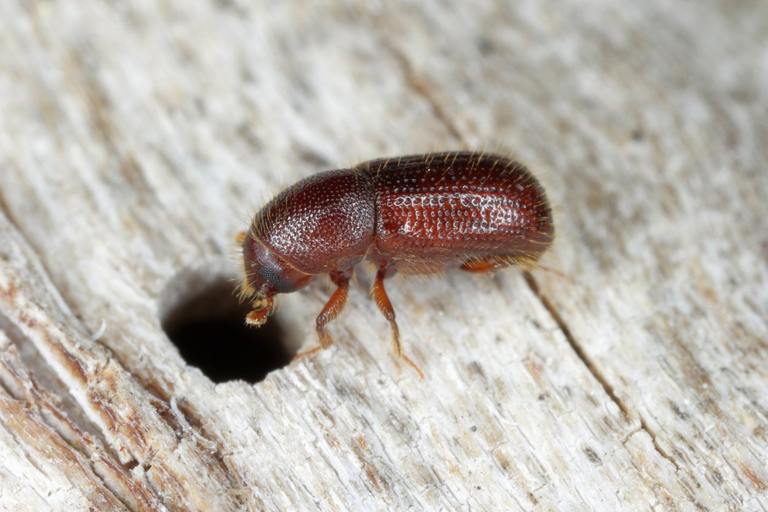Bark Beetles: Tiny Insects with a Big Impact on Forests
Published: September 5, 2025

Introduction
When people think of threats to forests, the first things that often come to mind are wildfires, logging, or storms. But there’s another, much smaller danger that causes just as much damage: the bark beetle. These tiny insects may measure only a few millimeters long, but their ability to multiply quickly and infest trees makes them one of the most destructive forest pests in North America and beyond.
In this blog, we’ll explore what bark beetles are, why they are so destructive, the signs of infestation, and how pest management professionals—and homeowners—can address the problem.
What Are Bark Beetles?
Bark beetles are small, hard-bodied insects that burrow into the bark of trees to feed and reproduce. With over 600 species in North America alone, bark beetles are widespread, and while some species are native and play a role in forest ecology, others are invasive and particularly destructive.
Pine bark beetles, for example, are a major threat to pine forests across the United States. These beetles are among the most economically and ecologically significant forest pests in the Southeast.
Life Cycle of a Bark Beetle
The life cycle of a bark beetle begins when adult beetles bore into a tree’s bark and lay eggs. Once the larvae hatch, they feed on the inner bark, disrupting the tree’s ability to transport water and nutrients. Over time, this feeding can kill even large, healthy trees.
A single bark beetle infestation can spread rapidly because these insects reproduce quickly. Under ideal conditions, some species can complete their life cycle in just a few weeks, allowing for multiple generations in a single season.

Why Are Bark Beetles So Destructive?
Bark beetles cause significant damage for a few key reasons:
- Tree Death – Their feeding weakens and eventually kills the host tree.
- Mass Attacks – Bark beetles release pheromones that attract more beetles, leading to mass infestations.
- Drought and Climate Stress – Trees already stressed by drought, wildfires, or other environmental factors are more vulnerable to bark beetle attacks.
- Spread of Fungi – Many bark beetles carry blue-stain fungi, which further weakens trees by blocking water flow.
Signs of a Bark Beetle Infestation
Identifying bark beetle activity early is critical for controlling damage. Some common signs include:
- Small Holes in Bark – Exit or entry holes made by adult beetles.
- Pitch Tubes – Pine trees often respond by exuding sap, creating small resin clumps on the bark.
- Boring Dust – Fine, sawdust-like material near the base of the tree.
- Discolored Needles – Needles may fade from green to yellow, then red, before falling off.
- Galleries Under the Bark – When bark is peeled back, intricate tunnels carved by beetles and larvae may be visible.
The Role of Climate in Bark Beetle Outbreaks
In recent decades, bark beetle outbreaks have intensified, especially in the western United States. Warmer winters and longer summers have allowed beetles to survive in greater numbers and complete more life cycles per year. At the same time, prolonged drought has left trees weaker and less capable of fighting off attacks.
This combination has led to massive tree die-offs, altering ecosystems, increasing wildfire risks, and creating economic burdens for industries that rely on timber.
Integrated Pest Management (IPM) for Bark Beetles
Addressing bark beetle infestations requires a comprehensive strategy, often referred to as Integrated Pest Management (IPM). This approach combines prevention, monitoring, and treatment to reduce damage while minimizing environmental impact. The Integrated Pest Management Program highlights strategies for bark beetle management:
- Tree Health Maintenance – Keeping trees well-watered and healthy helps them resist attacks.
- Sanitation – Removing infested or dead trees prevents beetles from spreading.
- Chemical Treatments – Insecticides may be used preventively in high-value areas but are less effective once trees are already infested.
- Monitoring – Regular inspections for signs of beetle activity are essential.
The Importance of Early Detection
Because bark beetles reproduce quickly, early detection is key to preventing widespread damage. Forest managers, arborists, and homeowners should be vigilant in monitoring for early signs, especially during hot, dry seasons when beetle activity is highest.
Professional pest management services, like All “U” Need Pest, can play an important role in early detection and treatment, helping protect both residential trees and larger forested areas.

The Ecological Role of Bark Beetles
Although bark beetles are often seen as destructive pests, they also play a role in natural forest cycles. By killing older or weaker trees, they help make room for new growth and recycle nutrients back into the ecosystem. In this sense, bark beetles are part of a larger ecological balance.
The problem arises when their populations grow unchecked, often due to human-driven climate change, invasive species introductions, or suppression of natural forest processes.
Preventing Bark Beetle Infestations at Home
For homeowners, protecting trees from bark beetles involves proactive care:
- Watering – Regular watering, especially during dry spells, keeps trees resilient.
- Pruning – Removing dead or damaged branches reduces stress and prevents beetle entry points.
- Avoiding Injuries – Mechanical injuries to bark make trees more vulnerable.
- Firewood Caution – Avoid moving firewood long distances, as it may harbor beetles.
- Consulting Professionals – If signs of infestation appear, contacting a pest control service is essential for effective management.
Final Thoughts
Bark beetles may be small, but their impact on forests, wildlife, and even human communities is massive. Understanding how they operate, recognizing early warning signs, and implementing prevention strategies can make a big difference in protecting trees. With proactive care and professional support, we can manage bark beetle risks while preserving the health of our landscapes.
If you suspect bark beetles are affecting your property, don’t wait. A timely response can save trees and prevent long-term damage.